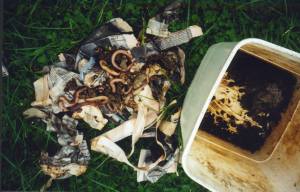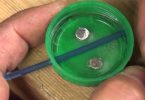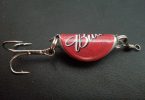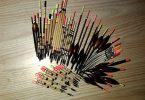September.
A misty, late afternoon rain has dampened the ground, and now an evening mist is moving through the shrubbery. Perfect conditions for night-time stalking.
Moving quietly and slowly is the key, all senses attuned for the slightest sign.
I see my target, wait my moment, then strike!
Success!
Now the tussle begins, as my prey tries to head back to the depths. I apply a firm and steady pressure, and feel a stronger pressure in response. I’m going to lose it!
Then, through my fingers I feel it weakening. Now the steady battle is going my way.
Suddenly the prey gives in.
I almost whoop as another enormous lobworm slides out of its hole into my grasp, and gets dropped into the small bucket, already containing a dozen or so of its companions.
There is an art to gathering lob worms from a wet lawn at night.
Under the cover of darkness, particularly on warm damp nights, lobworms will crawl out of their holes, seeking food and sex on the surface of the lawn. Stretching along the ground, sensing their surroundings. They are known as night crawlers in America.
Worms sense everything through their skin. They feel the slightest vibration. Their skin is light sensitive, and the full beam of a torch will send them shooting back beneath the ground.
You need to either hunt, using just the edge of the beam to locate your prey, or better, cover the centre of the lense with a disc of brown paper. As with all stalking, moving quietly and slowly is essential.
Even the expert gatherer has trouble grasping a worm quickly and firmly enough to prevent it disappearing with lightening speed.
Exposed on the surface, they are a favourite prey of foxes and hedgehogs. Evolution has endowed them with senses to detect a threat moving in on them quickly, and a lightening response.
If you are lucky enough to grab one firmly, the chances are that it will, literally, half escape. The worm breaking somewhere in the middle as the other half heads towards Hades, to heal and to re-grow its missing portion. The trick is to apply just enough pressure to stop the worm escaping, and not so much that it breaks. It takes practice.
If the worm has managed to bury itself sufficiently, you are not going to win the tussle, without gripping the worm so hard that you’ll badly damage it.
Let it go.
Gripping them too tightly will damage and bruise them badly, and then they will rot in the bucket. Better to let them slip back into the earth, perhaps you’ll catch the same worm, or its offspring, some other night.
Night time gathering will get you enough lobs for a session, but it’s not every night that will produce a successful hunt.
 What I do, is to go out when conditions are right and place my harvest in a plastic bucket, filled with wet newspaper. They will keep for weeks. In fact, I keep two buckets on the go. If I don’t use them within 2 or 3 weeks, I let the first lot go, and start filling the bucket again, that way I always have a good supply of fresh lobs available, and the lawn stays stocked.
What I do, is to go out when conditions are right and place my harvest in a plastic bucket, filled with wet newspaper. They will keep for weeks. In fact, I keep two buckets on the go. If I don’t use them within 2 or 3 weeks, I let the first lot go, and start filling the bucket again, that way I always have a good supply of fresh lobs available, and the lawn stays stocked.
Another way of gathering lobs is to ‘charm’ them. The secret is to send vibrations into the ground, mimicking the approach of a hungry mole, causing the worms to shoot out of the ground around you.
You can often see sea gulls doing this, stamping their feet on the local football pitch or cricket ground.
Bury the tines of a garden fork into the lawn and gently tap the handle. If you have the knack, the worms will appear. I don’t seem to have the knack myself.
When I worked for a while in Holland, I’d often see local anglers out charming worms on the neatly manicured grass verges, before cycling off with their garden fork strapped to their bicycle and a full pot of worms swinging from the handlebars.
When the weather is hot, and the soil is dry, the worms will be far too deep in the soil to reach. If you can, keep a shady area watered to maintain a supply. Another dodge is to spread an old carpet, or some close woven hesian sacking onto a concrete path or patio, close to the lawn. Sprinkle a few handfuls of earth beneath it and keep it wet. When you need a supply of worms, lift the mat and, with luck, you’ll find several worms sheltering beneath.
Lobworms are not for farming, but there are some things you can do to increase the supply from your lawn.

Those perfect lawns, you sometimes see, are not the best places for gathering worms. An angler’s lawn should be full of biodiversity. Pesticides and herbicides should have no place in the tool shed. In autumn, feed the lawn. No, not with those patent lawn fertilisers, but by spreading rotted organic compost. It may make the lawn look a bit untidy for a few days, but the worms will enjoy the feast, pulling the organic matter down into the earth, fertilising the roots of the grass and the ‘lawn plants’.
Worms deal with fallen leaves in a similar fashion, pulling them below the surface to rot. I can’t remember the figures, but I remember how impressed I was with the weight of leaves a worm can drag below. People with pristine lawns have to gather and dispose of fallen leaves themselves; anglers have better things to do with their time.
Worm Farming
Lobworms are great bait for certain species and situations, but often you’ll need something a little smaller. Red ‘compost’ worms, perhaps brandlings. These types of worm are the ones that can be farmed in an old plastic bin at the bottom of the garden.

If you dump your lawn mowings into a pile, you’ll probably find plenty of compost worms, feeding in the bottom layer of the pile, and in the one or two inches of soil beneath the heap. You’ll often see blackbirds searching for these worms, tossing and scattering the rotting grass around the sides of the heap.
To ensure a constant supply, you can start your own worm farm in a dustbin, or even a large plastic bucket, perhaps kept on the balcony of a tower block flat.
Not only will you have a steady supply of bait, but a source of rich garden compost. You’ll also be able to feel good about not sending your kitchen scraps to the local tip, to produce foul smelling acidic waste, leaching out the chemicals and heavy metals from plastics, batteries etc., polluting the water-supply and the local rivers.
I use a cheap and easy worm farm system developed by Jim Hay, Full details of which can be obtained in a pamphlet from the Henry Doubleday Research Association (HDRA), National Centre for Organic Gardening, Ryton-on-Dunsmore, Coventry, CV8 3LG.
To keep and multiply ‘compost worms’, get a plastic dustbin and drill plentiful small holes for drainage, into the sides, at the bottom, up to about 150mm. Fill the dustbin to slightly higher than this depth with an aggregate/sand mixture (about 2 parts aggregate to 1 part sand) and fill this ‘sump’ with water.
Drill plenty of air holes in the bin lid.
On top of the sump, lay pieces of wood to make a partition. On top of the wooden partition, put in about 75 mm of sedge peat. (don’t use ordinary peat, this is far too acid). Introduce about 100 worms to the peat, and cover with some partly rotted, finely chopped vegetable waste (about 100mm), cover this with another layer of sedge peat or wet shredded newspaper. (see attached diagram).
After about 3 weeks, when the worms are really multiplying, start feeding more partially rotted vegetable waste, then another layer of peat/newspapers and keep this up until the bin is full.
Don’t feed more waste than the worms can cope with, and don’t let the bin get too damp, otherwise it all gets too acid and all of your worms will die :-(. Try to keep the temperature at about 25C.
A sign that the bin is becoming too acid is the appearance of thousands of small white worms (Enchytraieds). These do no harm.

Once the bin is full, leave for a month, then shovel out the top 2 thirds of the contents. Sieve it, and use it sparingly as an organic fertiliser on the garden.
Return the worms to the bin and start filling it all over again.
Place the bin on some kind of tray to gather the seepage that makes an excellent organic fertiliser, mixed with water.
You will need to put the bin in a frost-free place during the winter, when the worms are likely to stop breeding and feeding so voraciously. Reduce the amount of food as the weather gets colder.
Using Worms
I doubt that there is a bait more versatile than worms. Fishing a worm bait is an adventure. It’s just as likely to be snaffled by a large pike, or a stickleback, as it is by the species you are targeting. On a flooded river, or a muddied pond, the vibrations given out by a struggling worm will call the fish in, through the confusing scent trails swirling in the disturbed water. The ‘plop’ of a lobworm, falling into the water, hard against the far bank, is as familiar to the chub as the sound made by large slug.
When I was a kid, dad constructed a pond in the back yard to supplement the old iron tank, which we had previously used to keep fish and other pond-life, and we had a large glass aquarium indoors. I spent a lot of time fish watching, instead of doing my homework.
Whenever I found a worm in the garden it would be offered as a treat to the denizens of one of these vessels, and I’d watch the unfolding drama.
If I simply tossed the unfortunate worm in from a distance, the fish would instantly turn toward the splash, become aware of the worm falling downward through the water, and dart forward to grab it. The lucky fish would then be chased around the pond, with half its meal hanging from its mouth.
If I approached the pond, the fish would usually flee to the other end, seeking cover in the weed. This would give me a chance to deposit the worm without the fish immediately becoming aware of it. I’d retire a little and watch, and learn just what makes worms such an effective bait.
Usually, the worm would become entangled and hidden in weed, its long head stretching out, waving and sensing its watery surroundings. The fish, gaining in confidence, would emerge from their refuge in the thick weed and resume their day to day business.
First one, then another, would sense the vibrations of the worm’s explorations, turning toward its hidden position, often from several feet away. Then slowly they would inch forward, seeking information from the faint vibrations in the water. As they came closer, you could almost see their body language change from exploration to targeting, as they recognised the creature moving about in front of them. Carefully and slowly, they would position themselves for the strike. A sudden forward dart, and they had it. Then would come the chase, as the rest of the shoal pursued their lucky companion, the worm dangling from its mouth.
So that was the secret of the worm. Presented on a hook, it must be active, and free to wave sinuously, calling your quarry and hastening its own doom.
The two biggest problems facing someone using worm as bait for the first time are getting it onto the hook, and making sure that the hook is in the fish’s mouth when they strike.
If you are fishing a water where only barbless hooks are permitted, then you can all but forget using live worm as bait (this is one of the problems of applying blanket bans of any sort. It may have no effect at all on ‘mainstream’ anglers but can devastate a ‘specialist’s’ sport).
What you must do, is match the size of the hook you are using to the size of the worm.
Trying to mount a strong, squirming lobworm onto a size 16 hook is an exercise in futility. Chances are that all you’ll succeed in doing is to damage the worm. It’s unlikely to stay on the hook for too long either. A size 6 hook is far more practical. Don’t worry about using such a large hook, after all any fish that can get a lobworm into its gob, isn’t going to notice a size 6 hook.
Remember what I said above about fish swimming off with just the end of the worm in their mouth, pursued by their companions? This is the second problem; getting the part of the worm with the hook into the fish’s mouth.
Giving the fish time to swallow the complete worm isn’t the answer. The very last thing you want to happen is to deep hook a fish. Especially, as you have every likelihood of striking into a specimen perch or eel, both of which have vital organs close to their throats. These organs can so easily be fatally damaged by a piercing hook, or a probing disgorger. Given that a specimen eel could be around 70 years old, being the cause of its death isn’t something I for one would be happy with.
If you are using a fairly long worm, consider chopping it in half. Half a worm will wriggle just as effectively as a whole worm, and will release more fish-attracting juices too.
Try piercing the worm at the end furthest from the head, pull the hook all the way through, so that that end becomes threaded onto the line, then push the hook through the skin, and out again, a little behind the worm’s head. This will allow the head to wriggle seductively, with the hook close by.
A fish is likely to target the free head end, rather than the end threaded to the line.
With smaller worms, pierce them through one end, and again behind the head, so that they form a ring on the hook, with both ends wriggling enticingly.
To help prevent the worm escaping, try pushing a small piece of elastic band over the barb (or perhaps a blade of grass), this will act as a stop and keep the worm secure. (John Roberts is now marketing small rubber tags, designed for holding deadbaits onto trebles. These are also perfect for worms or luncheon meat – ask your local tackle dealer).
Chopped Worms
When using worms as hookbait, matchmen in particular use chopped worm as groundbait. Preparing chopped worms can be a messy business. I’d recommend getting hold of one of those simple patent onion choppers, failing that, a food-blender, but whatever you do, don’t let the wife catch you!
Introduce it to your swim using a cup feeder, if you are using a pole, otherwise, mix the chopped worm with white crumb, just sufficient to bind it and feed small balls.
Further Reading
For more information try these sites: –
http://www.mjjsales.com/articles/how-to-compost.html
http://www.empnet.com/worms/resource.htm
http://www-aghort.massey.ac.nz/departs/soilsc/cybsoil/lesson/worms








